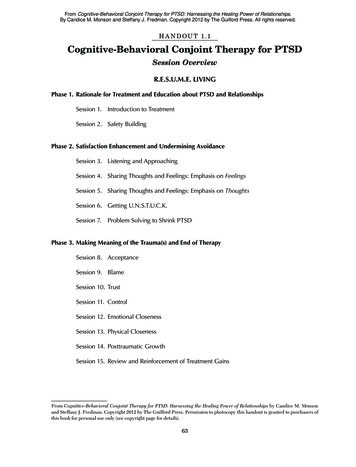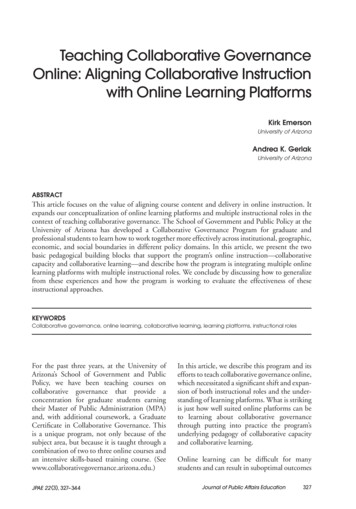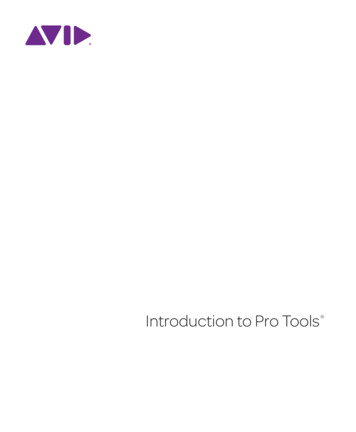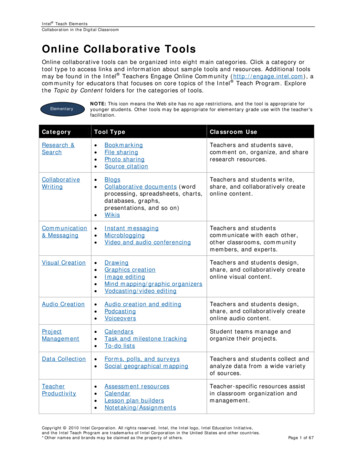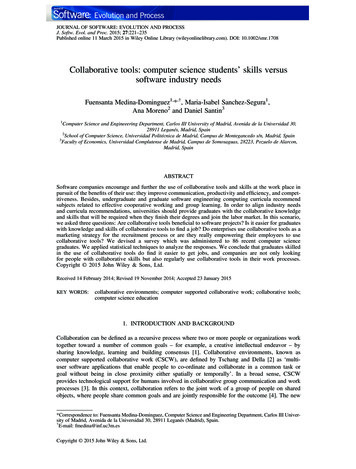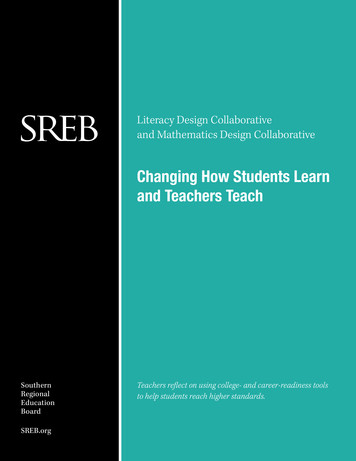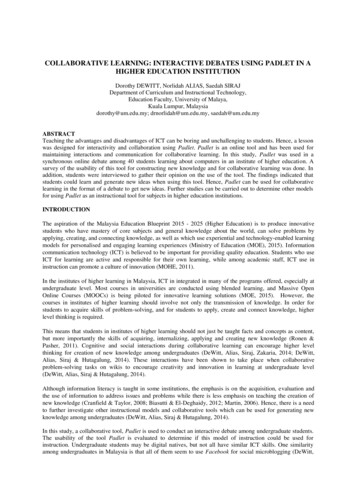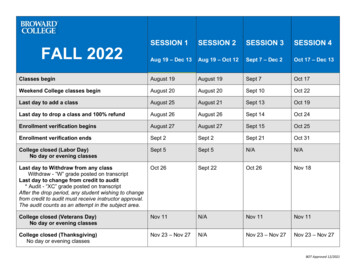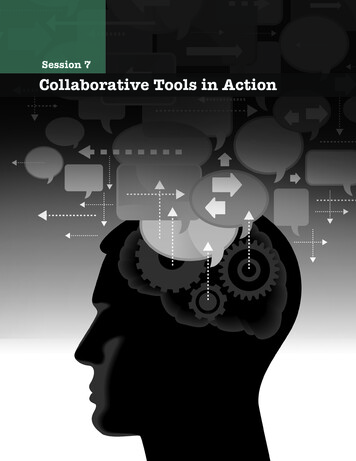
Transcription
Session 7Collaborative Tools in ActionCopyright 2012 SEDLConnecting Kids to Mathematics and Science7.1
AcknowledgmentsConnecting Kids to Mathematics and Science was made possible through the generoussupport of the following foundations:Educational Foundation of AmericaKDK-Harman FoundationRGK FoundationCopyright 2012 SEDLAll rights reserved. Educators and nonprofit organizations are welcome to use excerpts fromthis publication and distribute copies at no cost to recipients. Such users should credit SEDL aspublisher and respect the copyrights of designated illustrators, designers, and contributors. Foradditional uses of this publication, including reproduction or utilization in any form or by anymeans, electronic or mechanical (e.g., photocopying, recording, or by any information storageand retrieval system), please request permission in writing from SEDL at 4700 Mueller Blvd.,Austin, TX 78723 or by filling out and submitting a SEDL Copyright Request Permission format http://www.sedl.org/about/copyright request.html on the SEDL website.SEDL4700 Mueller Blvd.Austin, TX 78723800-476-6861www.sedl.org
Session 7Collaborative Tools in ActionObjectives1. Participants will understand how different collaborative tools can be used in the classroomto enhance the learning experience.2. Participants will use collaborative tools in a problem-based learning environment.Facilities ParticipantsA room with Internet access, a data projector, speakers,tables, and space for participants to spread out in groupsand work comfortablyUp to 25 teachersTime Required6 hoursElectricity as required for powering participants’ computersEquipment/Materials Computer with Internet access and data projector for facilitator Laptop computers with Internet access (1–2 per group) Digital camera (1 per group)SoftwareComputers should also have current installations and updates of Java QuickTime FlashHandouts1:2:3:4:5:Creating a BlogGarden Experiment BlogCollaboration ToolsClassroom ImplementationInstructional Unit PlanFacilitator Preparation Read the session guide and familiarize yourself with the activitiesand handouts 1–5. Make copies of handouts 1–5 and upload the files to Google Docsfor participant access during the session.Copyright 2012 SEDLConnecting Kids to Mathematics and Science7.3
SESSION 7: Collaborative Tools in Action Preview all the websites used in the session to ensure the links are current. Bookmark each site. Ensure adequate numbers of materials for all participants and groups. At the appropriate time, input handouts 1–5 into Blogger for group contributions. Review the BSCS 5Es Instructional Model (see Session 1: Handout 1). Review the related Texas Essential Knowledge and Skills (TEKS) Technology Applications standardslisted at the end of this session.Prerequisite Skills of Participants and Facilitator Basic computer skills Thorough understanding of Web navigation Solid understanding of all the websites and/or software addressed in this session (facilitator)Grouping StrategyUse a heterogeneous grouping strategy. Ensure that each group of three to four members includes bothmath and science teachers, as well as elementary school teachers who teach in self-contained classrooms. Thinkstock.7.4Connecting Kids to Mathematics and ScienceCopyright 2012 SEDL
SESSION 7: Collaborative Tools in ActionSession SequenceThe sequence of activities in this session will provide participants with introductory experiences with andknowledge of online resources and tools for collaborating and sharing lessons, resources, and experiences.Participants will begin by becoming familiar with Blogger as a means to collaborate online. Blogger is partof the suite of Web 2.0 tools available through a free Google account. After reviewing the garden exampleused in the previous sessions, participants will design their own blog to gather and share data as well asphotos and their experiences. The activity will conclude with a whole-group discussion to share the learning with all the participants.Equipment/MaterialsEngageComputer with Internetaccess and data projector forfacilitator (optional)Laptops with Internet access(1–2 per group)Table Groups1.Organize participants into heterogeneous groups of three to fourmembers. Plan for a 3-minute transition from whole group to table groups.2.Introduce the concept of a blog. A blog is an online log (Web log blog) of a person’s or group’sactivity. It can read like a diary or like a constantly growing magazine. The real power of a blog is inreaders’ ability to comment on it and to quickly search it for information.Ask the participants to explore a few different blogs created for classroom use, such as Mrs. Yollis’Classroom Blog (http://yollisclassblog.blogspot.com/) and Mrs. Cassidy’s Classroom Blog (http://classblogmeister.com/blog.php?blogger id 1337).3.Give the groups 15 minutes to discuss the content, design, and purpose of each blog. Participantsshould also discuss how they could use a blog in their classrooms.Whole Group4.Ask the table groups to report on the purpose of each blog site and the benefits of having a class blog.Equipment/MaterialsExploreTable Groups5.Computer with Internetaccess and data projector forfacilitator (optional)Laptops with Internet access(1–2 per group)Handout 1: Creating a Blog(on Google Docs)Now that participants have a basic idea of what a blog is and itsbenefits, ask each table group to create a blog using Blogger. Thisonline application is part of the suite of Web 2.0 tools available through a free Google account.Addressing the whole group, provide basic information about Blogger. Then instruct each groupto select one member to use Blogger to set up a blog. Eventually all group members will haveCopyright 2012 SEDLConnecting Kids to Mathematics and Science7.5
SESSION 7: Collaborative Tools in Actionadministrative access to this blog. Ask the participants to open Handout 1: Creating a Bloglocated in Google Docs. Orally lead or allow the groups to follow the steps in Handout 1 to setup a group blog.6.Tell participants: “Now the fun part begins. From the Blogger settings page, you can view yourblog (currently empty), change its settings, and start writing. As a group, take some time to clickthrough the different options, settings, and templates to develop your group blog. Decide as agroup on a design template and on any other preferences you would like to use.”Whole Group7.Tell participants: “For the last six sessions, we have used the gardening project as an example ofhow to integrate mathematics, science, and technology. The gardening project was used simply toprovide everyone with a common example and reference point.”“Now, your group will have the opportunity to develop your own integrated unit using the context ofyour choosing. Before you begin, please review your curriculum and state standards to determine atopic that would meet your students’ educational needs. In your groups, identify the topic and thecontent objectives in mathematics and science that you will develop.”To guide the discussions, help the groups brainstorm some possible topics and content connections.The following are some examples: Skateboard or toy car ramps to study angles as well as kinetic and potential energy Kites or paper airplanes to investigate the relationship between surface area and Bernoulli’sprinciple Model boats to identify appropriate units and measures, application of surface area and mass,and buoyancy and densityTable Groups8.Give the groups 30 minutes to identify a topic and content objectives as well as how the blog will beused in the unit. At the end of that time, groups should be prepared to share this information withthe whole group.ExplainWhole Group9.Invite a representative from each table group to share the following: Group topic Content objectives How the blog will be used to gather and share data in the unitAsk the whole group for additional suggestions, ideas, or relevant resources the table groups mayconsider as they develop their units more fully.7.6Connecting Kids to Mathematics and ScienceCopyright 2012 SEDL
SESSION 7: Collaborative Tools in ActionEquipment/MaterialsElaborateWhole Group10. Tell participants, “Remember, one of the components of the unitis to collaborate and share our experiences. We will continueto use the garden unit as the common example for whole-groupdiscussion, and your group should then apply the principles toyour specific topic.Computer with Internetaccess and data projector forfacilitator (optional)Laptops with Internet access(1–2 per group)Handout 2: GardenExperiment Blog (1 electroniccopy per group)Handout 3: CollaborationTools (1 electronic copy perparticipant)Handout 4: ClassroomImplementation (1 perparticipant)Handout 5: Instructional UnitPlan (1 electronic copy perparticipant)“To that end, in the garden example, groups of students in a classcould be responsible for ‘adopting’ a portion of the garden. Eachgroup would then be responsible for documenting the growthof the plants in its portion of the garden. The documentationcould include photos of the plants as well as data, such as growth rates, weather details (e.g.,temperature, rainfall), insects and animals, and anything else related to the content that willinterest the students. You may even have the blog take on the ‘voice’ of a plant or animal.”Table Groups11. Explain to participants that one of the things they need to consider and communicate to students isthe criteria for group projects. Discuss the benefits of teachers’ sharing a rubric and guidelines withstudents before they start using a blog.Then, ask the groups to determine how they would monitor and evaluate student work on a blog. Forfuture reference, each group should list on its blog the criteria members would use.Whole Group12. Ask each group to report out how its members would monitor and evaluate student blogs. Aftereach group presentation, ask the other participants for feedback and to share any additional ideasthey have.13. Tell participants they next need to consider and discuss the components their units should contain, ascovered in previous sessions: BSCS 5Es Instructional Model format (Session 1 handout) Video (Session 3) Outdoor learning experiences (Session 3) Web research (Session 4) Assessment rubric (Session 5) Online collaboration––blog (Session 7) Community resources (will discuss in Session 8)Copyright 2012 SEDLConnecting Kids to Mathematics and Science7.7
SESSION 7: Collaborative Tools in ActionTable Groups14. Give the groups approximately 2 hours to begin planning their instructional units, including usingthe Blogger site to collaborate and record information in their blogs. Provide each group with anelectronic copy of Handout 2: Garden Experiment Blog. Using the handout as a guide, one personin each group should post on the group’s blog similar suggestions for the group’s unit. For example,group members should discuss possible protocols and guidelines regarding the required informationthat needs to be posted to the blog by all participants. The discussion should also include howto best use the blog, including how to add photos, documents, student work, and any data thatmembers think are relevant to the project. An additional component to discuss would be howeach school may go about establishing blogs for students to communicate and interact with fellowstudents and teachers.15. Provide each participant with copies of Handout 3: Collaboration Tools (electronic copy) and Handout4: Classroom Implementation. Instruct the groups to use the handouts, as well as other resourcesthey identify, to guide their unit planning. In addition, they should use Handout 5: Instructional UnitPlan (electronic copy) to record group decisions, roles, and responsibilities.16. Participants will have additional time in Session 8 to continue development of their integrated units.17. Inform the participants that in Session 9, each group will have 30 minutes to share its unit with thewhole group.Equipment/MaterialsEvaluateWhole GroupComputer with Internetaccess and data projector forfacilitator (optional)Laptops with Internet access(1–2 per group)18. Ask each group to report out its progress on developing itsintegrated unit. After each group presentation, ask the whole group to provide feedback andsuggestions on the design and details of the following: Content Video Outdoor learning component Blog19. Ask one member of each table group to make notes on the blog for reference when the group nextmeets to work on its unit. Guide the group discussion and ask the groups to share insights. Whenthey are done, they will need to “publish” the blog.Whole Group20. Reflection. Ask questions to elicit feedback on the process the groups experienced: “What were someof the challenges? What went surprisingly well? How could you use this process in the classroom toset up student blogs?”7.8Connecting Kids to Mathematics and ScienceCopyright 2012 SEDL
SESSION 7: Collaborative Tools in Action21. After the discussion, inform the groups that they will be responsible for following through andcompleting the units in the next session. Each group should use its blog to continue to collaboratebetween sessions.22. At this point, recap and debrief the day.Technical Assistance Follow-UpThe technical assistance provider will ensure that all school groups access, review, andadd updates, reports, and so on regarding the development of the units. This continuedexperience and improved expertise is essential to participants’ ability to utilize collaboration tools in practical classroom applications.The technical assistance provider will take the information from Handout 5 for each teamand contact all team leaders within 3 days to set up a tentative schedule for follow-upactions. Depending on the team’s needs, the follow-up should include the following:1. Calls to or from team leaders or team members to assist and answer any questionsdealing with the instructional unit design and development2. Site visits to provide technical assistance with the unit design and development3. Site visits to provide technical assistance in the implementation of the unit, such asclassroom observation of a unit lesson or lessons4. Site visits to provide assistance with post-lesson activities, such as reviewing studentwork and meetings to reflect on content or pedagogyTexas Essential Knowledge and Skills (TEKS)Please note, not all of grades 4–8 have standards that relate to this session. Avoid “stretching” the session to make it apply to TEKS other than those listed below. This effort would not be an appropriate useof the students’ learning time.§126.3. Technology Applications, Grades 3–5.(b) Knowledge and skills.(6) Information acquisition. The student evaluates the acquired electronic information. The studentis expected to:(A) apply critical analysis to resolve information conflicts and validate information;(B) determine the success of strategies used to acquire electronic information; and(C) determine the usefulness and appropriateness of digital information.(7) Solving problems. The student uses appropriate computer-based productivity tools to create andmodify solutions to problems. The student is expected to:(A) use software programs with audio, video, and graphics to enhance learning experiences;Copyright 2012 SEDLConnecting Kids to Mathematics and Science7.9
SESSION 7: Collaborative Tools in Action(B) use appropriate software to express ideas and solve problems including the use of wordprocessing, graphics, databases, spreadsheets, simulations, and multimedia; and(C) use a variety of data types including text, graphics, digital audio, and video.(8) Solving problems. The student uses research skills and electronic communication, withappropriate supervision, to create new knowledge. The student is expected to:(A) use communication tools to participate in group projects;(B) use interactive technology environments, such as simulations, electronic science ormathematics laboratories, virtual museum field trips, or on-line interactive lessons, tomanipulate information; and(C) participate with electronic communities as a learner, initiator, contributor, or mentor.(10) Communication. The student formats digital information for appropriate and effectivecommunication. The student is expected to:(A) use font attributes, color, white space, and graphics to ensure that products are appropriatefor the defined audience;(B) use font attributes, color, white space, and graphics to ensure that products are appropriatefor the communication media including multimedia screen displays, Internet documents, andprinted materials; and(C) use appropriate applications including, but not limited to, spreadsheets and databases todevelop charts and graphs by using data from various sources.(11) Communication. The student delivers the product electronically in a variety of media, withappropriate supervision. The student is expected to:(A) publish information in a variety of media including, but not limited to, printed copy, monitordisplay, Internet documents, and video; and(B) use presentation software to communicate with specific audiences.From: Texas Administrative Code (TAC). Title 19, Part II, Chapters 111, 112, 126. (2010). Texas Essential Knowledge and Skills. Copyright by the Texas Education Agency (TEA).All rights reserved. Available from http://www.tea.state.tx.us/index2.aspx?id 6148. Reprinted by SEDL with permission of TEA.ReferencesBybee, R. W., Taylor, J. A., Gardner, A., Van Scotter, P., Carlson Powell, J., Westbrook, A., & Landes, N.(2006). The BSCS 5E Instructional Model: Origins, effectiveness and applications. Retrieved l7.10Connecting Kids to Mathematics and ScienceCopyright 2012 SEDL
1. Participants will understand how different collaborative tools can be used in the classroom to enhance the learning experience. 2. Participants will use collaborative tools in a problem-based learning environment. Handouts 1: Creating a Blog 2: Garden Experiment Blog 3: Collaboration Tools 4: Classroom Implementation 5: Instructional Unit Plan

